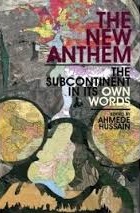The New Anthem: The Subcontinent In Its Own Words
Ahmede Hussain (ed.)
|
The Indian subcontinent has had its fair share of glory and tragedy. The glory comes through a recapitulation of the circumstances which have historically gone into the making of its composite character. The tragedy has been political, in that the subcontinent was destined to be broken asunder, with lives and futures all going down the slippery road to disaster. And yet, more than six decades after the vivisection of the land, there is today a new cooperative effort among the descendants of the Partition generation to bridge the gap that has so long defined links, or the lack of them, between the three nations forked out of a once undivided India. And you spot that effort to narrow the chasm in the region of literature, into which area has now stepped the young Ahmede Hussain. In The New Anthem: The Subcontinent In Its Own Words, Hussain brings together the subcontinent, as it were, in the perception(s) of its writing classes. To be sure, authors in India, Pakistan and Bangladesh (and quite a good number of them are part of the subcontinental diaspora) have in these past many years focused on their perspectives in literature, bringing into those thoughts a newer dimension into the intellectual workings of new generation minds. Niaz Zaman’s efforts, as also those made by Mohiuddin Ahmed of the University Press Limited, to bring South Asian writers together set off a new trend here in Bangladesh. Now, it appears, it is Ahmede Hussain’s turn to reinforce that trend, indeed carry it forward. As he looks at it, South Asian fiction is today a reality that has taken on an independence of its own. It is a new genre, having morphed into it from whatever may have been its previous state. That is the image you come across as you swim through the tales presented in this paperback. The richness is all, both in terms of the writers brought together and in the quality of the tales that come to you one after the other. The twenty-two stories happen to be, as it were, a broad image of the subcontinent as it dominates the minds of the young. The writing is thoughtful and yet the language is fast paced, demonstrating none of the inhibitions that might have circumscribed expression in an earlier generation. You might be able to spot, as you go through Abeer Hoque’s The Straight Path, a degree of liberalism which has come into South Asian story-telling. The thoughts flow, and so does language which, you are well aware, springs from traditions sprouting in the West. You do not expect a twenty-seven year-old woman, in your social ambience, to develop a crush on a young man a decade younger. But there it is, in Hoque’s narrative. Sensuality and that certain bit of eroticism shake things up at the edge of the water. The wonders of the flesh apart, there are in this anthology stories that plumb the depths of human psychology. Read Qaisra Shahraz’s The Malay Host, where duplicity combines with tourism to throw up a tale of misery. The owner of the home, almost a model one, fawns over his western visitors and yet there is a viciousness about him that is revealed only at the end of the tale. By then, everything has burned down. There are only the ashes that remain. When you reflect on ashes, you are pulled back into thoughts of politics, even if momentarily. Much was reduced to ashes in the brutal summer of 1947. Ironically, much has been rebuilt, in a way, in times that remain quite removed from that horrible parting of the ways. But you cannot really stay away from a remembrance of the old bitterness. Dwell, if you will, on Saadat Hasan Manto. In Tabish Khair’s creative imagination, the tragedy of Manto comes alive. Read Night of 16th January 1955. It is Manto the tragedian who speaks. He has observed much, suffered much, in his journey from the expansive world of an integrated India to the narrow confines of Pakistan. And he has paid a price. The soliloquy says it all. It is a bitter soul in full expression of his misery. The final words encompass that misery: ‘Don’t laugh, saale. Make a peg for me before it is dawn.’ Closer to your surroundings, indeed within your surroundings, it is Carl Bloom who brings forth the dichotomy of experience that is Dhaka in The Alley. On the one hand, it is elitism as exemplified by private universities that the visiting American academic is brought up against; and, on the other, it is the molestation of a poor, scantily clad and famished woman in the falling light of day she becomes an unwilling witness to. The irony is inescapable. It is a gallery of storytellers you have here. Mahmud Rahman, Kamila Shamsie, Amit Chaudhuri, Padma Viswanathan, Khademul Islam, Mohsin Hamid, Sumana Roy, Sharbari Ahmed, Rachael Khan and so many others make a beeline for your attention. The danger is in the possibility of your falling in love with them all, with the craft they seek to uphold here. Syed Badrul Ahsan| 14 Oct 2009 | The Daily Star
|


 Ahmede Hussain
Ahmede Hussain